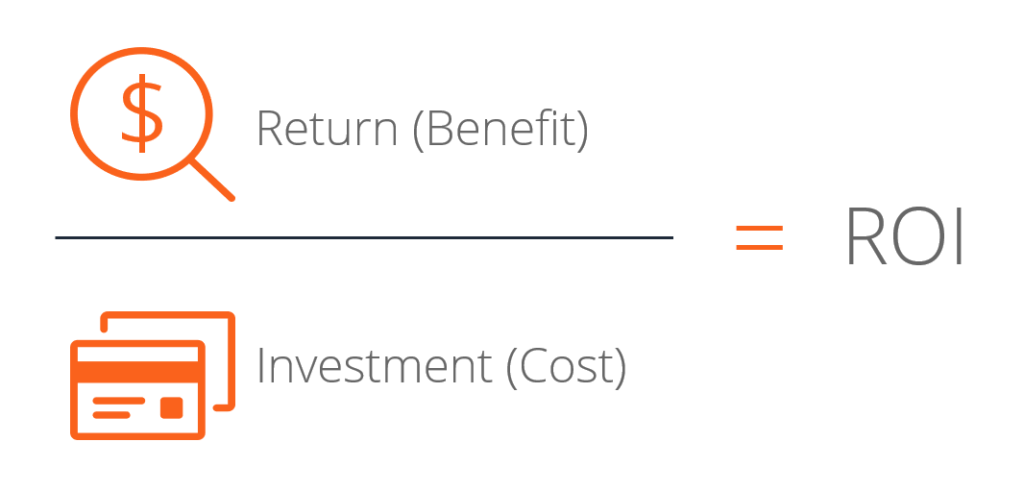
Running a successful training course for your employees is great.
Seeing your net profits increase is thrilling.
But being able to link your net profits to your training is game-changing and in today’s post, we’re going to show you exactly how to do just that. If you're looking for easy ways to measure the ROI of training, here's our guide to measuring the ROI of employee training in 6 steps.
Why measure the ROI of employee training?
Training isn’t free and, just like any other business investment, it should give you a positive return on investment (ROI). Measuring ROI shouldn’t just be an afterthought to your training: it should be front and center as one of the specific outcomes.
If you’re looking to increase the status of your training and justify future expenditures, nothing beats a snazzy ROI infographic to really grab the attention of your stakeholders. Most trainers and managers believe that training offers value – such as increasing efficiency, or driving bottom line profits – but ROI data lets you prove the value of your training. In this post, we’ll show you exactly how to measure the ROI of employee training in six simple steps.
How to calculate the ROI of employee training in 6 steps
Want to calculate the ROI of your employee training? Here are the exact six steps that you’ll need to follow:
-
Identify outcomes of employee training
-
Place a monetary value on the outcomes
-
Isolate the effects of the employee training
-
Annualize the data and compare pre- and post-training results
-
Determine employee training costs
-
Apply the ROI formula
Let’s look at each of these six steps in greater detail.
Step 1. Identify the outcomes of employee training
The goal of ROI calculations is to show the cost to benefit ratio of a training course or program. Every successful training program offers benefits, the trick is deciding which ones to focus on and then converting them into a monetary value.
Training outcomes can broadly be categorized into two main camps: tangible and intangible
Tangible outcomes of employee training
Some examples of tangible outcomes include:
-
To increase sales
-
To boost new accounts
-
To increase market share
-
To improve working or production speed
These outcomes are tangible because you can readily obtain data from before and after the training and easily calculate the difference. This gives you a concrete value that translates to the value offered by the training.
Intangible outcomes of employee training
Intangible outcomes are more problematic to measure and relating them to standard business impacts such as sales, revenue and market share can be challenging.
Examples of intangible outcomes;
-
To increase customer engagement
-
To boost customer loyalty
-
To increase teamwork
-
To improve employee engagement
These outcomes can be more abstract and subjective, making them difficult to isolate. However, it is possible to calculate both tangible and intangible outcomes if the correct approaches are used over a suitable time frame.

Step 2. Place a monetary value on the outcomes
Once your organization’s stakeholders or managers have selected the outcomes they want to study, the next step is assigning a monetary value to these outcomes. Measuring tangible outcomes such as productivity or sales is far more straightforward so we’ll begin there first.
Example 1. Measuring productivity
For this first example, imagine you’re the operations manager of a solar panel installation firm. You have ten employees and each employee can install 1.2 solar panels per hour, on average. After sending your staff for training designed to increase their productivity, you can measure their rate of work to find that they can now install 1.4 solar panels per hour. This 16.6% increase in productivity can be used to calculate a monetary value to the outcome.
Assuming the hourly rate of your staff is $19.53, you can state that the training has enabled each employee to generate an additional $3.24 of value for the company for each hour they work. To expand this, you can look at the annual salaries and obtain an annual figure.
This works fine for jobs where the outcomes are easy to measure and relate directly to the training. However, many outcomes are fuzzy, and people’s job roles are difficult to define and their output is difficult to track and measure.
In this case, you could use a supervisor assessment. This type of assessment helps you assign a dollar value to an intangible outcome, based on the employee’s annual salary.
Managerial work is typically unstructured and difficult to measure. In this case, a senior manager could use an observation form to assess the performance of a middle manager before and after training, to highlight any improvements.
The areas typically assessed might include:
-
Task completion rate
-
Task complexity
-
Teamwork
-
Communication
The same assessment is given before and after training and the difference is calculated. The improvement in the manager's performance can be stated as a percentage. When viewed against the manager’s annual salary, the percentage represents a monetary value and this represents the net profit of a training.
Example 2. Measuring improvements in leadership and communication skills
For this next example, let's say that you want to measure the ROI of a training course in leadership and communication skills for a group of managers. You run the training and then use supervisor assessments to determine that each manager has received a five percent performance boost, on average. How would you use this data to calculate ROI?
If the manager’s annual salary is $80,000, then the five percent impact made by the training would be worth $4,000 per year and this would represent the net benefit of the training.
If you're wondering which metrics to use, here are the top 15 training ROI metrics you should know.
Step 3. Isolate the effects of the employee training
There are a wide number of methods to isolate program effects, depending on the type of job role, the nature of the training and the type of outcomes being studied. The most common methods include:
-
Using a control group (a group of employees who receive no training)
-
Trend line analysis (using performance data)
-
Forecasting
-
Estimates of program impact (by participants, supervisors or managers)
-
Use of expert guidance or data from previous studies
-
Customer input
These methods can be used to calculate or estimate the impact of other factors. To continue our earlier example regarding leadership and communication, one way to isolate the effects of the training would be to use a control group.
In our example, the supervisor assessment indicated that the training had helped deliver a five percent improvement in the manager’s efficiency. To use a control group, you could conduct the same supervisor assessments on another manager that didn’t receive the training and compare the results. Were the improvements the same or different? You can use this data to help estimate the impact of other factors and isolate the effects of the data.
Step 4. Annualize the data and compare pre- and post-training results.
The fourth step is to annualize the data, by converting the data to a 12-month estimate. This helps to compare the pre-training results with the post-training results.
Step 5. Determine employee training costs
Calculating training costs aren’t as simple as just knowing the costs of the course and the instructor. You have to know both the direct and indirect costs.
Why is the training cost information important?
Training cost information helps us to understand the total expenditure of training, including direct and indirect costs. You can determine the proportion of money spent on training development, admin and evaluation. It also helps us compare the cost of alternative training programs.
Examples of direct costs of employee training
Direct costs include the cost of conducting the training (ie. the instructor, materials, and venue). They should also include development costs if you developed the training in-house. Other direct costs include facilitating surveys and evaluations and processing the data to create reports.
Examples of indirect costs of employee training
Training has a whole host of indirect costs that may include:
-
Compensation for trainees, such as stipends or travel expenses in addition to their salaries while attending the training.
-
Staffing costs, such as hiring temporary workers to cover the regular worker’s duties while they attended training.
-
Productivity costs, i.e. the value the employee(s) would have added were they at work. For example, a sales person is expected to add at least twice the cost of his/her salary once benefits such as tax, insurance, benefits and tools like phones and computers are accounted for.
Step 6. Apply the ROI formula
The ROI formula helps estimate the dollar return from each dollar invested in training. The formula is:
ROI% = (Net profit – Cost of training)/Cost of training X 100.

Putting it all together: Examples of measuring ROI of employee training
In the following section, we’ll offer two brief examples of how to successfully measure the ROI of employee training in six simple steps.
Example 1: Solar Photovoltaic (PV) Installer Efficiency Training
Step 1: Identify outcomes of the employee training
Each solar PV installer receives training designed to improve the rate at which they can install solar PV cells. The desired outcome is for the installers to be able to install solar panels faster after the training than they could before. This can be measured through practical tests before and after the training and the improvements can be expressed as a percentage.
Step 2. Place a monetary value on the outcomes
According to the U.S. Bureau of Labor Statistics, the median annual wage for solar PV installers in 2018 was $42,680 per year. The percentage improvement generated by the training can be used to place a monetary value on the outcome, based on the median annual wage.
For example, if the training resulted in a 5 percent productivity improvement, the net benefit of the training would be worth five percent of $42,680 = $2,134 per year.
Step 3. Isolate the effects of the employee training
To ensure that the test is measuring the effects of the training and excluding other factors you could create a control group of solar PV installers who were given the exact same practical tests but did not receive any training. Comparing the control group to the group who received the training helps ensure that any productivity improvements were most likely due to the training and not other outside influences.
For example, if the installers who received the training scored a five percent productivity improvement, yet the control group notched a one percent productivity improvement you could roughly estimate a true improvement of four percent, worth $1,707.2, per installer per year.
This is just one very rough example of isolating training effects using a simple control group. Depending on your time and budget, you could also use trend line analysis, forecasting methods and customer input.
Step 4. Annualize the data and compare pre- and post-training results
Looking at work records could help calculate the average working rate of the solar PV installer prior to the training. To annualize the data from the post-training results, you can look at the average hourly wage and multiply it by the average number of working days per year.
In our example, we already estimated that the training added $1,707.2 of value to each installer per year, so no further calculations are required.
Step 5. Determine training costs
First, add the direct costs and indirect costs (development costs + overhead costs + compensation for trainees). In this example, let’s suppose that the basic training cost $1,000 per employee once all direct and indirect costs were factored in.
Step 6. Apply the ROI formula
In our example, we’ll assume that ten solar PV installers received the training, giving a total training cost of $10,000. The annualized net profits were $17,072 for all ten employees.
ROI = (17,072 - $10,000)/$10,000 X 100 = 7.072%
This shows us that the ROI of employee training in this case was 7.072%.
Example 2: Sales Management Leadership Training
Step 1: Identify outcomes of employee training
In this next example, a group of three sales managers is given leadership training. The intended outcome of the training is to improve their leadership skills. This will be assessed by a senior manager via supervisor assessments, once before and once after the course.
The assessment has four areas:
-
Communication skills
-
Teamwork
-
Efficiency
-
Work completion
Each area is scored out of 100. The pre- and post-training assessments can be compared, giving an improvement figure. For instance, if a manager received a score of 55 for teamwork in the pre-training assessment, and a score of 60 in the post-training assessment, the would have increased their teamwork skills by nine percent.
Step 2. Place a monetary value on the outcomes
Data from the U.S. Bureau of Labor Statistics shows that the median annual wage for a sales manager was $124,220 per year in 2018. To obtain a monetary value on the improvement between the pre- and post-training supervisor assessments, the percentage improvement will relate to the sales manager’s annual wage.
For example, the post-training supervisor assessment indicated that the three sales managers who had completed the leadership training had shown a seven percent improvement, on average. This gives a net profit increase of $8.695.4 per manager.
Step 3. Isolate the effects of the employee training
To isolate the effects of the training, senior management may wish to place three additional sales managers into a control group. They are given the exact same supervisor assessments but receive no additional training. This helps ensure that any improvements seen in the group that received training were related to the training and not external factors.
For instance, the use of a control group could find that while the sales managers who received training posted a seven percent improvement, the control group’s scores were half of one percent higher on average. You could revise down the first figure to 6.5% to eliminate other potential influences. This would give a net profit from the training of $8.074.3 per sales manager.
Step 4. Annualize the data and compare pre- and post-training results
In our example, the net profit of $8.074.3 per sales manager is already annualized.
Step 5. Determine training costs
By adding the direct costs and indirect costs we find that the leadership training cost $5,000 per sales manager or $15,000 for the whole group.
Step 6. Apply the ROI formula
In our example, our group of three sales managers received training valued at $15,000 in total and this gave a net profit of $24,222.9.
ROI = (24,222.9 - $15,000)/$15,000 X 100 = 61.486%
This shows us that the ROI of employee training was 61.486% in this example.

Conclusion
As we've shown, it is possible to successfully measure the ROI of employee training in just six simple steps. For the vast majority of cases, this simply 6-step solution will help any company determine the rough ROI of any particular course or training. Overall, ROI calculations are most straightforward for manual and/or highly structured tasks and more complex for more flexible roles such as managerial positions. For more examples of how to successfully calculate the ROI of employee training, be sure to ask us for a free demo to see how we can help you achieve your goals.
